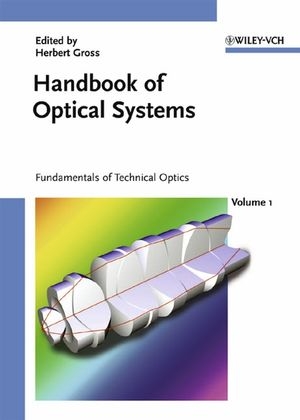
Handbook of Optical Systems
Wiley-VCH (Verlag)
978-3-527-40377-6 (ISBN)
- Titel gebraucht verfügbar
- Artikel merken
Herbert Gross, born in 1955, joined Carl Zeiss in 1982 after finishing his physics degree as specialist for optical design. Since 1995 he has been working as head of the department of optical design, while also teaching as a lecturer in Aalen and Lausanne.
The new handbook is an intuitive, didactically elegant approach to the subject of optical systems and is not competed by any other work on the market. The selected board of authors, all reputed industrial experts, guarantee the timeliness of the well coordinated, coherent chapters.
This first volume of the handbook introduces readers to the basics of geometrical and technical optics. For an understanding
of optical systems, it is necessary to be familiar with the paraxial optics, the methods of ray tracing, the notations of geometrical optics and the description of optical systems. Very often the simple geometrical model is not sufficient to understand complex systems, therefore the wave optical model and the effects of light sources and receivers are discussed here too.
Special components, such as gratings, prisms or aspherical lenses are described in detail to provide an understanding of
modern complex systems. A short introduction into aberrations and the testing of optical systems allow readers to consider
and control the quality of optical systems.
Herbert Gross was born in 1955. He studied Physics at the University of Stuttgart and joined Carl Zeiss in 1982. Since then he has been working in the department of optical design. His special areas of interest are the development of simulation methods, optical design software and algorithms, the modelling of laser systems and the simulation of problems in physical optics, and the tolerancing and measurement of optical systems. Since 1995, he has been heading the central optical design department at Zeiss. Dr. Gross served as a lecturer at the University of Applied Sciences at Aalen and at the University of Lausanne, and gave seminars for the Photonics Net of Baden Württemberg as well as several internal company courses. In 1995, he received his PhD from the University of Stuttgart for a work on the modelling of laser beam propagation in the partial coherent region. He has published several papers and has given many talks at conferences.
Vol 1 : Fundamentals of Technical Optics
1 Introduction
2 Paraxial optics
3 Dielectric interfaces
4 Materials
5 Raytracing
6 Photometry
7 Lightsources
8 Sensors and receivers
9 Theory of color
10 Optical systems
11 Aberrations
12 Waveoptics
13 Plates and prisms
14 Gratings
15 Special components
16 Testing
"... ein hervorragender Auftakt für ein Referenzwerk ... Zahlreiche Tabellen, Graphiken und Illustrationen geben einen raschen Überblick über grundlegende mathematische Gesetzmäßigkeiten und Zussammenhänge. Bewährte Darstellungen werden übernommen, zusammengefasst und durch aktuelle und praxisnahe Beispiele ergänzt, die die Handschrift eines Experten mit langjähriger Erfahrung tragen. Dadaurch wird der erste Band zu einem Handbuch im wörtlichen Sinne. Freuen wir uns auf die weiteren Bände." Photonik
"'Fundamentals of Technical Optics' ist...für Ingenieure und Wissenschaftler, die sich professionell mit Optik beschäftigen, zu empfehlen. Dabei kann das Buch für diese Zielgruppe als Lehrbuch und Nachschlagewerk gleichermaßen dienen. (...) Ich kann das Buch ohne Einschränkungen alle denjenigen empfehlen, die professionell optische Systeme entwickeln oder beabsichtigen, selbiges zu lernen." Physik Journal
"...notwendigen Grundlagen der paraxialen Optik, der Fotometrie bzw. Radiometrie, der Strahldurchrechnung als auch Materialeffekte und wichtige Nebenaspekte.Hervorzuheben ist dabei die Tiefe, die das Buch für die rein optischen Themenfelder aufweist." Optolines
"Seit Jahren fehlt ein Optikbuch, das den technischen Aspekt der Optik in der Tiefe darstellt. Mit dem 'Handbook of Optical Systems - Band 1' wird diese Lücke geschlossen. Das klar gegliederte Handbuch besticht durch hohe Informationsdichte und starken Praxisbezug."
Laser + Photonik
"... the first of a six-volume series intended to provide a comprehensive understanding of the principles governing the design and simulation of optical systems ... recommended."
CHOICE
"...a compendium of information that would be of interest to optical engineering, physicists and others."
American Reference Books Annual
"The first two out of six volumes of the series Handbook of optical systems comes with more than 800 fullcoloured illustrations and images for an easy understanding of complex optical systems. [...] This series can be used by professionals as a comprehensive reference as well as an introduction for beginners in technicaloptics."
Colloid Polym Sci
| Erscheint lt. Verlag | 21.1.2005 |
|---|---|
| Reihe/Serie | Handbook of Optical Systems ; 1 | Handbook of Optical Systems ; 1 |
| Sprache | englisch |
| Maße | 170 x 240 mm |
| Gewicht | 1710 g |
| Themenwelt | Naturwissenschaften ► Physik / Astronomie ► Optik |
| Schlagworte | Electrical & Electronics Engineering • Electrical & Electronics Engineering • Elektrotechnik u. Elektronik • Optical Communications • Optics & Photonics • Optics & Photonics • Optik • Optik u. Photonik • Optische Geräte • Optische Nachrichtentechnik • Photonik • Physics • Physik |
| ISBN-10 | 3-527-40377-9 / 3527403779 |
| ISBN-13 | 978-3-527-40377-6 / 9783527403776 |
| Zustand | Neuware |
| Haben Sie eine Frage zum Produkt? |
aus dem Bereich



